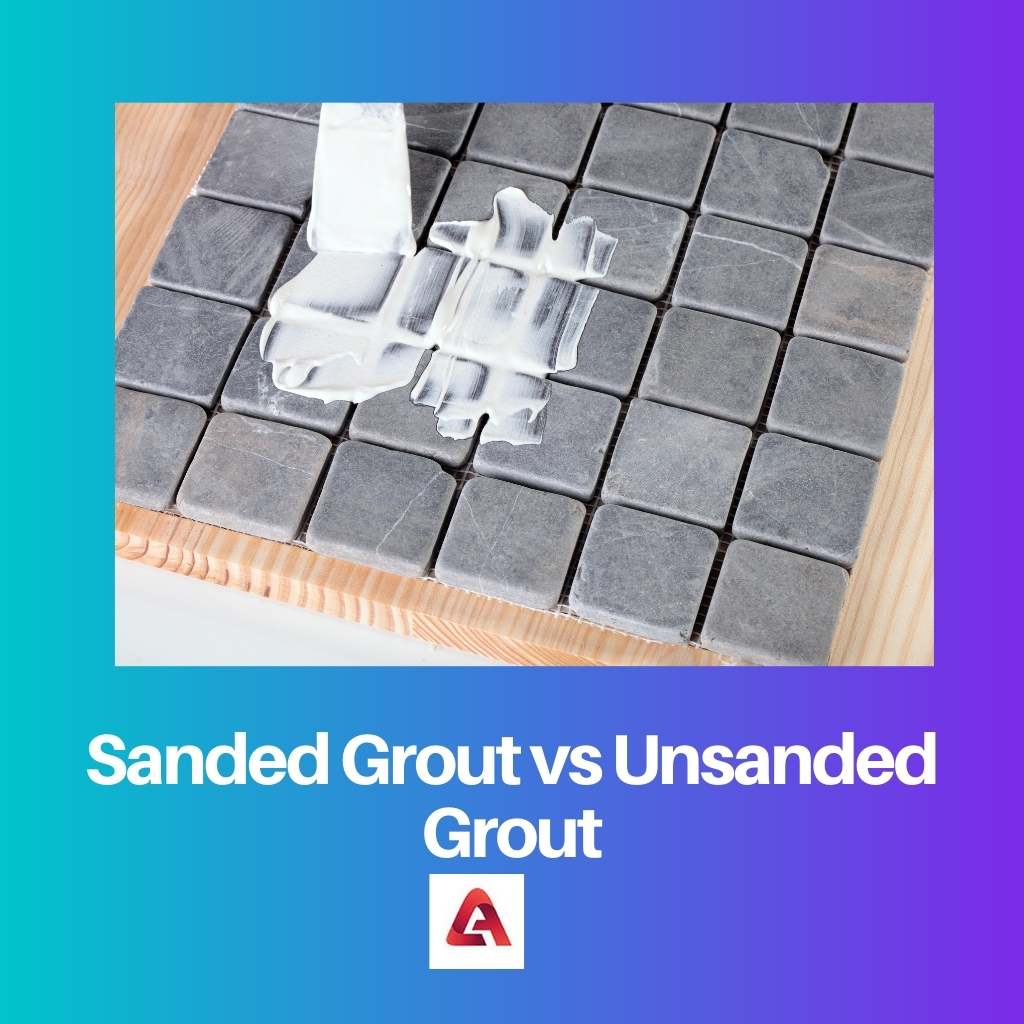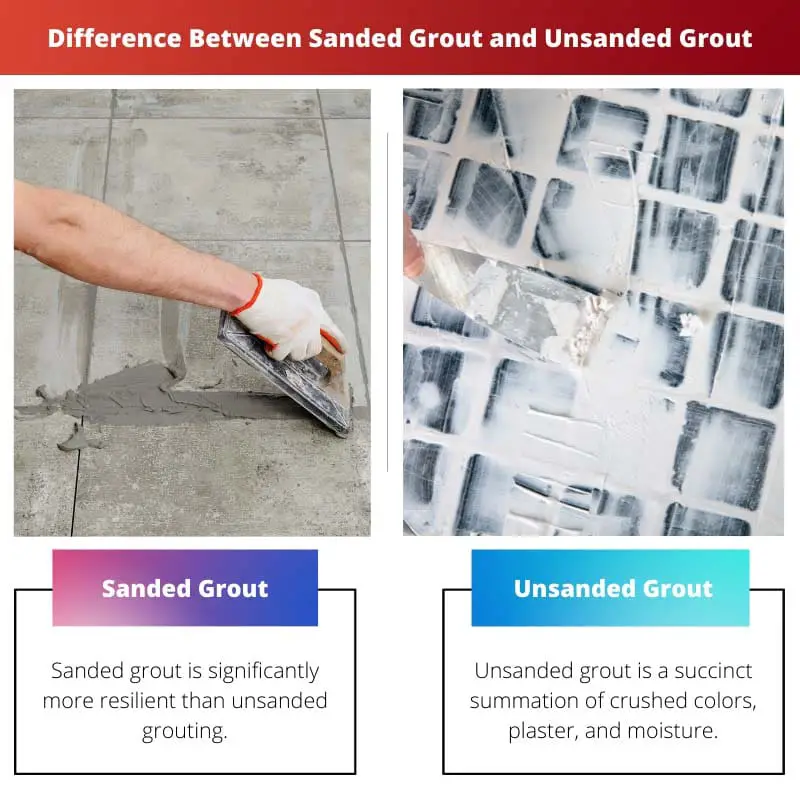Grout, a putty-like substance that fills the gap among tiles and holds them firmly in position, is used by every householder working on a DIY flooring project.
However, although grout is widely used for home renovation, most are unaware that it is available in two types: sanded and unsanded.
This article will help you learn about your alternatives for constructing: your dining center countertop or laying an entrance flooring.
Compare and contrast sanded and unsanded grout because then you can create the correct selection when purchasing materials for your new renovation planning and execution.
Key Takeaways
- Sanded grout contains fine sand, making it more durable and suitable for wider joints between tiles.
- Unsanded grout has a smoother texture and is ideal for narrow joints and delicate surfaces, such as glass or marble tiles.
- Choosing the appropriate grout depends on factors like tile type, joint width, and desired appearance.
Sanded Grout vs Unsanded Grout
Sanded grout contains sand particles, which make it stronger and durable. It is used for wider gaps between tiles, and is suitable for use in high-traffic areas such as floors or countertops. Unsanded grout, does not contain sand particles and is smoother and more malleable than sanded grout.

When you acquire some sanded grout from your local convenience shop for managing your flooring somehow, it is the same thing as it says in the packet.
It’s a typical grouting solution with the addition of aggregate grit.
Sanded grout is significantly more resilient than unsanded grouting for one obvious fact: it contains more molecule binds and is even water-resistant, which lets it be an anti-shrinkage agent as well.
When comparing the durability amongst both types of grout, sanded grout easily beats unsanded grout simply because it is more durable and is reliable even on monsoon seasons before and after.
On the other hand, unsanded grout is a succinct summation of crushed colors, plaster, and moisture that does not contain any aggregated sand.
Because of the costly polymer chains commonly employed as “binders,” unsanded grout is nearly significantly more expensive than regular sanded grout.
There is polymer composite and unsanded plaster grout, very much like sanded grout.
Because it is better suited for seams broader than 1/8-inch on weaker tiles that the sanded grout might damage, the epoxy-based unsanded grout comprises polymer chains and the curing agent.
Comparison Table
| Parameters of Comparison | Sanded Grout | Unsanded Grout |
|---|---|---|
| Components | Polyblend cement with silica crystals, aka sand, epoxy fragments, crushed colors, and inorganic aggregates. | Cement material, powdered hue fragments, glue, and polymer chains are mixed in water. |
| Shrinkage | Shrinkage is very less. | Shrinkage is more with moisture. |
| Cost | Half the price of unsanded grout. | Twice the price of sanded grout. |
| Durability | More durable and resistant to moisture and high temperatures. | Less durable and is used for finer gaps that are less exposed to high temperatures. |
| Texture | Has a coarse and granular texture. | Fine and smoothened texture. |
What is Sanded Grout?
Sanded grout, as the term suggests, includes fine particles of quartz sand that are used to strengthen the architecture of the grout and increase its longevity.
As a result, if you feel it with your fingertips, it seems rougher and has a chalky surface. You can see the sand particles in the mixture just by glancing at it.
This sandblasted grout is made out of crushed colors, water, concrete, and grit.
Sanded grout is available in two types: plaster and epoxy-based. The resins, curing agent, and sand are all mixed in the epoxy sanding grout. Epoxy grouts are used in regions that are subjected to severe toxins since they are more durable.
It comes in a variety of shades and hues. This might aid in generating a strong visual difference or complementing the tile color. Gravel in the grout helps to bind the grout and produce a firm connection.
As a result, sanded grout is unlikely to fracture or deform. It’s great for places with a lot of pedestrian traffic since it can resist the strain.
Because sanded grout adheres faster and shrinks less than unsanded grout, it’s perfect for any tile having joints that are 18″ to 12″ wide. Attempting to squeeze the heavy items into smaller joints may lead to a sloppy, uneven, and crack-prone finish.
What is Unsanded Grout?
The unsanded grout is finer than sanded grout; therefore, working into tighter spaces is simpler. Because there are no sand grains in unsanded grout, it has a smooth texture.
As a consequence, it works well with scratchable and soft tiles like limestone and marble. It is less likely to damage the tiles than harsh sanding grout.
Unsanded grout, on the other hand, isn’t tough enough to resist pedestrian traffic. As a result, it is rarely used in locations where people walk since it may rapidly shrink.
It is not sufficient enough to resist the tiles together over a long period for bigger joints than 1/8-inch. This implies that any shrinking that occurs after the cement dries and cures would have no impact on the grout’s long-term resilience.
Grout that has not been sanded is weaker in adhesive properties. It diminishes as it dries. You can use unsanded grout if longevity is not a problem for you.
However, putting it in a high-traffic area may need regrouting, as unsanded grout is costly.
Unsanded grout, also known as non-sanded grout, is designed for gaps that are somewhat smaller than 1/8-inch thick.
As the water in the grout dries, it shrinks, and unsanded grouting shrinks almost as much as sanded grout.
Main Differences Between Sanded Grout and Unsanded Grout
- Sanded grout is cheaper than unsanded grout.
- Sanded grout’s major element is the presence of silica in it, whereas unsanded grout does not contain silica and has polymerizing chains instead.
- Sanded grout is used for heavy mending, whereas unsanded grout is used for smaller gaps and crevices among tiles.
- Sanded grout is more durable than unsanded grout.
- Sanded grout does not shrink, whereas sanded grout shrinks with moisture.




